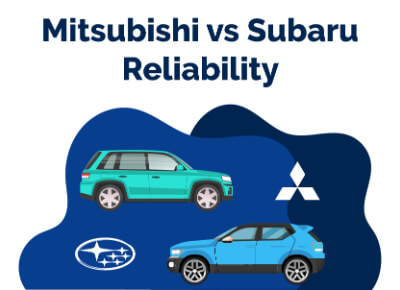Mitsubishi vs Subaru: Reliability Comparison
July 16, 2023


Chris is Head of Content for FindTheBestCarPrice and is based out of Philadelphia, PA. As a seasoned automotive industry analyst and car enthusiast, he ensures the highest level of quality across all our content and curates our picks for the best deals each month.
Chris studied information systems and marketing at Drexel University and writes about a wide range of topics ranging from car buying tips to troubleshooting common mechanical issues.
When he’s not thinking about cars, he likes to stay in with his dog and make an “attempt” to finish a crossword puzzle (he’s not quite at the Saturday/Sunday level…yet). As a former cheesemonger, Chris still has a “sharp” passion for all things cheese, and his fridge is always loaded with it!
Chris also has a passion for things that go fast, and drones are no exception. He spends some of his time writing for Dronesourced.
When considering a new vehicle, reliability is a key factor that can make or break your decision.
Two brands often come head-to-head in the reliability debate: Mitsubishi and Subaru. Each has its loyal following and its own set of strengths.
In this post, we'll delve into a comprehensive comparison of Mitsubishi and Subaru, examining their reliability track records, customer feedback, and what expert reviews have to say.
Whether you're in the market for a rugged SUV or a performance-oriented sedan, understanding how these brands stack up in terms of reliability will equip you with the knowledge you need to make an informed choice.
Table of Contents
Mitsubishi vs. Subaru Reliability: Detailed Comparison
| Features | Mitsubishi | Subaru |
| Design | ||
| Repairs and Maintenance Cost | ||
| Durability | ||
| Engine | ||
| Gas Mileage | ||
| Technology | ||
| Safety |
Mitsubishi or Subaru?
The contention over the superior vehicle, whether a Mitsubishi or a Subaru, often evokes strong and contrasting opinions. Each brand has a rich automotive industry history and delivers distinctive features and benefits.
Mitsubishi has garnered a reputation for manufacturing dependable, high-performing automobiles distributed across more than 160 countries globally.
Mitsubishi is primarily an industry leader because of its state-of-the-art technology and impressive designs.
In contrast, Subaru has cemented its position as a leader in producing robust all-wheel-drive vehicles that can smoothly navigate any terrain. The company's utilization of high-torque boxer engines has also generated a devoted following among automotive enthusiasts.
Additionally, Subaru's commitment to safety, evidenced by its implementation of features like the EyeSight driver-assist technology, has made it a popular choice among families and safety-conscious drivers.
While both brands have distinct advantages, selecting a Mitsubishi and a Subaru will ultimately hinge on individual predispositions and specific necessities.
Those searching for high-performance and innovative technology may find Mitsubishi the more appropriate option. Meanwhile, those in pursuit of sturdiness and all-terrain capabilities may find Subaru to be the ideal choice.
Design
Mitsubishi's approach to design revolves around an empowering and benevolent philosophy, which seeks to offer customers an immersive experience that unlocks new possibilities and encourages them to embark on new adventures confidently.
With its innovative craftsmanship and unconventional design principles, Mitsubishi creates a balance between form and function that captures the imagination and anticipates unanticipated needs, thus elevating its status as a clear winner in design and innovation.
In contrast, Subaru's design language is deeply rooted in the brand's core principles of safety, dynamic performance, and efficiency.
Leveraging its expertise in aerospace engineering, Subaru's design language embodies the distinctive Dynamic x Solid design, complemented by the iconic six-star emblem.
Additionally, the front-mounted horizontally opposed engine, which takes inspiration from nature's most stable shape, is a testament to the brand's engineering prowess.
Regarding design and innovation, while Mitsubishi impresses with its imaginative design approach, Subaru's focus on safety and engineering proficiency makes it the ultimate victor.
Winner: Both
Repair and Maintenance Cost
Regarding the cost of ownership, Mitsubishi emerges as the frontrunner with its attractive pricing model.
The brand offers a relatively low intermediate maintenance and repair cost of $7,787 over ten years, although the likelihood of a significant repair is 18.18%.
Mitsubishi's low cost of ownership gives it an edge over most of its competitors despite its rates being higher than the industry average.
On the other hand, Subaru's models have an average maintenance and repair cost of approximately $8,798 during their first decade of service, which is $1,984 more than the industry average for famous brands.
The likelihood of needing a major repair within this time is also higher at 20.15%. As such, Mitsubishi comes out as the clear winner in terms of cost of ownership.
Winner: Mitsubishi
Durability
Mitsubishi vehicles have an average lifespan of 150,000 to 200,000 miles or 10 to 13 years, although specific problems may arise after exceeding 100,000 miles.
On the contrary, the Mitsubishi Outlander boasts a prodigious lifespan of 13 to 17 years and can surpass the great distance of 250,000 miles, provided conscientious maintenance and prudent driving practices are observed.
In contrast, while deemed reasonably dependable, the Mitsubishi Lancer can endure an estimated range of 150,000 to 200,000 miles with customary upkeep.
Subaru, renowned for producing reliable cars, has a reputation for lasting between 150,000 and 200,000 miles and over 15 years without encountering significant issues.
Furthermore, according to Subaru, 98% of their vehicles sold within the last decade still operate today, indicating their remarkable longevity.
Winner: Mitsubishi
Engine
Mitsubishi's diminutive yet dynamic four-cylinder turbocharged engine is a force to be reckoned with. It is bolstered by an exceptional 310 lb-ft of torque, making it a formidable adversary in any automotive arena and Delivering a prodigious 295 horsepower.
The engine's lightweight composition gives it an elegant and supple demeanor on the road, highly prized by discerning drivers who place a premium on handling and maneuverability.
In contrast, Subaru's Boxer engine, which sits horizontally in the engine bay, endows the vehicle with outstanding balance and control, rendering a more stable and self-assured driving experience.
Its lowered center of gravity minimizes noise and vibration, resulting in a silky-smooth ride.
Additionally, Subaru's engines are renowned for their durability, with most models capable of enduring over 150,000 miles without any significant problems.
A whopping 98% of Subaru vehicles sold in the last decade are still plying the roads today, a testament to the brand's reliability and longevity.
Winner: Mitsubishi
Gas Mileage
Mitsubishi models provide an impressive fuel efficiency rating of 25 miles per gallon in the city and 30 miles per gallon on the highway, thanks to its lightweight design and regenerative braking system.
This ingenuity boosts the fuel economy, making it an acceptable choice for those who want to save money on gas.
However, Subaru takes the lead in fuel efficiency with its Crosstrek Hybrid, which runs on gas and electric power, delivering an estimated fuel mileage rating of up to 90 miles per gallon.
The other Crosstrek variants and several Forester and Outback SUVs offer excellent highway fuel mileage ratings of up to 34 miles per gallon, making Subaru the clear winner in fuel efficiency.
Winner: Subaru
Technology
Mitsubishi's AWC and MI-PILOT technologies provide drivers with enhanced dynamics control, balance, and driver assistance on motorways.
AWC delivers precise handling and superior stability, while MI-PILOT reduces driver fatigue by assisting with acceleration and steering for extended periods.
On the other hand, Subaru's Symmetrical All-Wheel Drive technology offers superior traction and safer driving on all roads, built specifically for Subaru vehicles.
The X-Mode with Hill Descent Control further improves grip and traction in challenging conditions, providing a smooth and controlled driving experience.
Both manufacturers excel in their respective areas, with Mitsubishi focusing on handling and driver assistance while Subaru emphasizes traction and stability.
Winner: Both
Safety
Both Mitsubishi and Subaru are committed to providing advanced safety features to their drivers and passengers.
Mitsubishi has reinforced impact safety evolution (RISE) body construction, front pedestrian impact crumple zones, active stability control (ASC), anti-lock braking system (ABS), and traction control logic (TLC), among other features.
On the other hand, Subaru boasts its EyeSight driver assistance technology, which uses cameras to monitor the road ahead, detect potential hazards, and then warn the driver, prompting them to take action.
While both manufacturers offer advanced safety features, Subaru's EyeSight technology is a standout feature that is not found in Mitsubishi's vehicles.
Additionally, Subaru's seven standard airbags, ring-shaped reinforcement system, lower-positioned boxer engine, reverse automatic braking, blind-spot monitoring with lane change assist, and vehicle dynamics control (VDC) provide a comprehensive suite of safety features to protect its drivers and passengers.
Winner: Subaru
Final Verdict
Both brands provide multiple options to satisfy the needs of even the most selective driver.
They are both reliable brands, but the Mitsubishi is a better option going by the various categories covered in this piece.
Best Car Deals by Category
Posted in Car Buying Tips, Car Troubleshooting |




